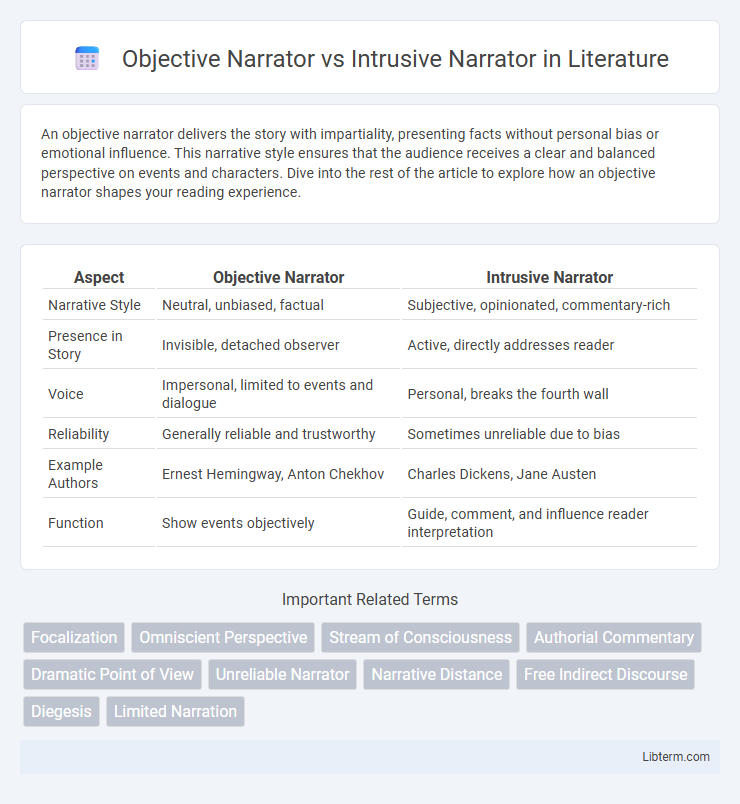An objective narrator delivers the story with impartiality, presenting facts without personal bias or emotional influence. This narrative style ensures that the audience receives a clear and balanced perspective on events and characters. Dive into the rest of the article to explore how an objective narrator shapes your reading experience.
Table of Comparison
| Aspect | Objective Narrator | Intrusive Narrator |
|---|---|---|
| Narrative Style | Neutral, unbiased, factual | Subjective, opinionated, commentary-rich |
| Presence in Story | Invisible, detached observer | Active, directly addresses reader |
| Voice | Impersonal, limited to events and dialogue | Personal, breaks the fourth wall |
| Reliability | Generally reliable and trustworthy | Sometimes unreliable due to bias |
| Example Authors | Ernest Hemingway, Anton Chekhov | Charles Dickens, Jane Austen |
| Function | Show events objectively | Guide, comment, and influence reader interpretation |
Understanding Narration: Objective vs Intrusive Narrator
An objective narrator presents the story without offering personal opinions or insights, allowing readers to interpret events independently. In contrast, an intrusive narrator interrupts the narrative to provide commentary, analysis, or direct addresses to the reader, influencing interpretation and adding subjective layers. Understanding these narration styles highlights how narrative voice shapes reader engagement and perspective within a literary work.
Defining the Objective Narrator
The objective narrator presents the story without revealing characters' inner thoughts or emotions, focusing solely on observable actions and dialogue. This narrative style maintains neutrality by avoiding commentary or subjective interpretation, allowing readers to interpret events independently. It contrasts sharply with the intrusive narrator, who frequently interjects personal opinions or additional context throughout the narrative.
Key Traits of an Intrusive Narrator
An intrusive narrator breaks the fourth wall by directly addressing the reader, offering personal opinions, and commenting on the story's events or characters. This narrator exhibits subjectivity, often guiding the reader's interpretation with explicit judgments or insights beyond the story's immediate perspective. Unlike an objective narrator who remains detached and impartial, the intrusive narrator actively participates in the narrative, blending storytelling with authorial commentary.
Narrative Distance: Impartiality vs Involvement
An objective narrator maintains narrative distance by presenting events and characters without inserting personal opinions, ensuring impartiality and allowing readers to interpret the story independently. In contrast, an intrusive narrator reduces narrative distance by directly addressing the audience, offering commentary, judgments, or insights, which fosters a sense of involvement and guides reader perception. The key distinction lies in narrative distance--objective narrators create detachment through neutrality, while intrusive narrators engage readers with subjective presence.
Impact on Storytelling: Tone and Reader Perception
An objective narrator maintains neutrality, allowing readers to form their own interpretations by presenting facts without commentary, which creates an impartial and immersive storytelling tone. In contrast, an intrusive narrator directly addresses the audience, influencing reader perception through commentary, opinions, or judgments, shaping the narrative tone with subjectivity and often adding layers of irony or humor. This difference significantly impacts reader engagement, as the objective narrator fosters distance and observation, while the intrusive narrator invites intimacy and active interpretation.
Character Insight: Showing vs Telling
An objective narrator presents characters' actions and dialogue without revealing internal thoughts, allowing readers to infer emotions and motivations through showing. In contrast, an intrusive narrator directly communicates characters' feelings and thoughts, telling the reader explicitly about their internal states. This difference affects the depth of character insight by balancing subtlety and clarity in narrative perspective.
Authorial Voice and Presence
An objective narrator presents the story with minimal authorial presence, maintaining distance and limiting insight into characters' inner thoughts, thereby allowing readers to interpret events independently. In contrast, an intrusive narrator actively engages with the audience through explicit commentary, judgments, or authorial voice, shaping the reader's understanding and emphasizing the narrator's authority within the narrative. The choice between these narrator types significantly influences narrative tone, reader engagement, and the overall control an author exerts over the storytelling process.
Reader Engagement and Trust
An objective narrator presents events and characters without personal bias, fostering reader trust through impartial and clear storytelling. In contrast, an intrusive narrator actively shares opinions or commentary, which can increase reader engagement by adding depth and personality but may challenge the reader's trust due to subjectivity. Balancing these narrative styles impacts how readers connect with the story and perceive its credibility.
Popular Examples in Literature
Objective narrators present the story with impartial, factual details, exemplified by Ernest Hemingway's "Hills Like White Elephants," where the narrator refrains from adding personal commentary. Intrusive narrators, as seen in Charles Dickens' "Bleak House," frequently address the reader directly and offer subjective insights, shaping the narrative with their opinions. Both narrative styles influence reader engagement by either maintaining neutrality or guiding interpretation through the narrator's presence.
Choosing the Right Narrator for Your Story
Selecting the right narrator is crucial for narrative tone and reader engagement, with an objective narrator presenting events without personal bias, allowing readers to form their own interpretations. In contrast, an intrusive narrator offers commentary and insights, guiding the audience's understanding and adding depth to the story's themes. Writers should evaluate the desired level of intimacy and control over the narrative voice to determine whether neutrality or direct involvement best serves their storytelling goals.
Objective Narrator Infographic

 libterm.com
libterm.com